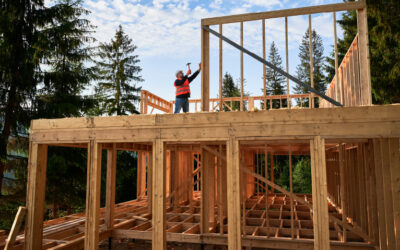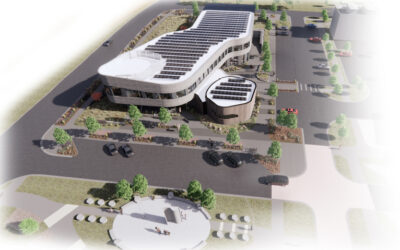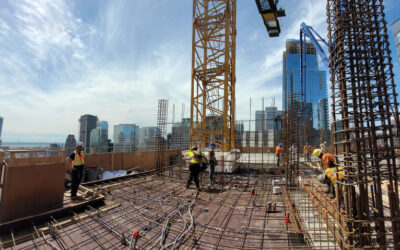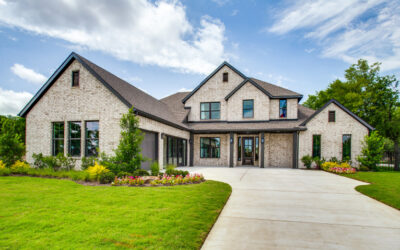Established in 2009, Stack Modular is a leading provider of innovative structural steel volumetric modular building solutions worldwide and is uniquely positioned to assist with ending the current affordable housing crisis while contributing to the greening of the construction industry.
As the only North American-owned company with integrated modular manufacturing operations in China, Stack Modular offers its clients significantly greater manufacturing capabilities than any competitor.
With offices in Vancouver, British Columbia, Calgary, Alberta, Mississauga, Ontario, and most recently Irvine, California; manufacturing facilities in Shanghai, Jiangsu, and Hong Kong; a managerial staff of 75; and the capability of hiring up to 500 project workers, Stack Modular has remained true to President Jim Dunn’s vision, “to disrupt the construction industry and revolutionize how the world builds.”
We enjoyed a wide-ranging interview with Geoff Baker, Stack Modular’s Vice President of Strategy, who brought to the company 15 years of experience in the modular industry when he joined four years ago, and Santiago Lazala-Silva, the company’s Marketing Specialist. They spoke of Stack’s beginnings and growth, partnership with Bird Construction, their capabilities, and how Stack is playing a key role in the move toward green buildings, energy efficiency, and solving the housing crisis.
Getting a start
Baker told us how company founder Jim Dunn was in Shanghai in 2009 when he had the idea of converting the shipping containers he saw on the docks into modules for offices and worker accommodation for the oil and gas industry, mainly in northern Alberta and Saskatchewan. However, Dunn quickly realized it would be much easier to build structural steel modules from scratch instead of converting containers that had been made for a completely different purpose.
“Jim also realized the strategic importance of manufacturing in China, the hub of the world’s supply chain, where just about anything can be sourced directly, bypassing exporters, importers, and brokers, [in whose hands] the price can quadruple. By manufacturing in China, Stack could operate efficiently and cost-effectively without sacrificing quality.”
After three years in business, and recognizing a tapering-off in the oil and gas industry, Dunn decided to change direction, moving to modular multi-family housing and other types of accommodation including hotels, student dormitories, long-term care facilities, and correction facilities.
Trajectory shift
A partnership with Bird Construction in 2017 marked a crucial turning point in the company’s trajectory, says Baker. “Jim had a vision of getting into larger projects, and to do that you have to think very differently.”
Traditional construction, he explains, has linear expenses, “starting with the architects, the groundwork, the site formwork, and ramping up for the finishing, but with modular construction, it’s the reverse. We need most of the money upfront, and the cash flow tapers off as we get close to finishing the project. So Jim’s vision was that we needed to partner with a large general contractor that could provide financial backing with a steady stream of sales and new jobs, and most importantly lend legitimacy to the project and our company,” he says.
“We were the first modular company to partner with a general contractor that we are aware of,” Baker continues. “It’s been an excellent partnership because there are huge benefits to being owned by a multi-million-dollar company that’s 105 years old. You don’t get to be that old by making bad choices, so this partnership has lent significant credibility to us and our projects.”
Today, Stack operates three manufacturing facilities in China with over 1.3 million square feet of manufacturing space and access to skilled North American-certified labour. But, best of all, using cutting-edge technology and streamlined processes, the facilities can produce 2,500 modules a year. With this capacity, Stack can offer a project schedule reduction of up to 30 percent to its clients when compared to traditional construction. This also translates into fewer worksite disruptions and reduced waste generated by the construction process.
Award winners
Stack Modular’s first major project in partnership with Bird Construction was the energy-efficient 102-room Asqarniit Hotel and Conference Centre, completed in 2019 on Baffin Island in Canada’s eastern Arctic, and winner of 2021’s ‘Permanent Modular Hotel Over 10,000 square feet’ from the Modular Building Institute.
Taking inspiration from Inuit culture, the asymmetrical structure was designed to be clad with LED-illuminated glass and steel in homage to the Northern Lights. After six months of fabrication in Shanghai, the 62 modules were loaded onto a breakbulk vessel at the port of Shanghai, crossed the Pacific to the Panama Canal, travelled up the Atlantic Coast to Baffin Island, and were delivered in July 2019, after 75 days at sea.
Asqarniit Hotel and Conference Centre was erected within 30 days, with fully functioning electrical, plumbing, and mechanical services. It was a remarkable accomplishment and one that would be impossible through traditional construction, given Baffin Island’s remoteness, bitter cold, and short periods of daylight. However, by scheduling its arrival and assembly in July, workers had almost 23 hours of daylight to complete the job.
In 2023, Stack Modular received three Awards of Distinction from the Modular Building Institute, the international non-profit trade association advocating for modular construction. Stack won awards for dormitories for Cedar Valley Lodge in Kitimat, British Columbia that will accommodate 4,500 LNG Canada project workers; for Kinshasa Patron Housing in the Democratic Republic of the Congo; and for IORDF, a correctional facility in Thunder Bay, Ontario.
“Corrections facilities typically take 30 to 36 months to design, build, and occupy, but we did two in 15 months for Infrastructure Ontario, with the other in Kenora,” Baker says.
After learning that 20 percent of the inmates in the existing Thunder Bay facility were Indigenous, Baker told us that Stack consulted with local First Nations groups about ways to make it a humane and healing place for Indigenous people. “We designed it with large windows and radiant in-floor heating, positioned it to look out over the lake, and chose colours so that each of the four wings represented one of the four seasons, important in Indigenous cultures. In every way, we tried to humanize the process and make it look less like a penitentiary, which is also beneficial for the staff.”
The greening of construction
From an environmental point of view, steel is a product that can be reused and most steel has a high recycled content, as opposed to wood, which is unusable when demolished. Steel is far more durable.
Adds Lazala-Silva, speaking from his experience of talking to plant managers: “There’s also a reduction of material usage, because less than three percent of the material we use is classified as waste, and can be recycled into new product. But in comparison, when there’s surplus or waste wood product in a construction project, it can’t stay in the cycle, either because it was cut too short for reuse or chemically treated, making it unsuitable for reclaiming. So, the way we build using steel is a lot greener, especially when compared with cross-laminated timber products.”
Baker goes on to tell us about the manufacturing contract Stack and Bird were awarded for a 14-story modular tower, the tallest modular structure in Canada, for BC Housing’s Permanent Supportive Initiative in Vancouver. When completed in early 2025, it will supply 109 intermediary housing suites for people who are homeless or housed precariously and will meet all passive house standards.
“[Passive House] is one of the most stringent environmental codes you can work to,” he says. “To meet the quality specs for passive housing, we need to have high-performance glass and windows and 10-inch thick exterior insulation. Typically, a passive house takes about 90 percent less energy to heat and cool. It’s a combination of airtightness, good insulation, good windows, and a good HVAC system. This one hits all the targets.”
However, as he notes, there is an added cost of 15 to 20 percent when building a passive house and there is likely to be a trade-off between environmental considerations and affordability.
Affordable housing – the need for change
Always mindful of costs, Stack Modular was able to reduce the project cost of a multifamily complex in Norwalk, California by 45 percent using an Integrated Delivery Approach, collaborating with AWI Architects, Bernard’s Construction, and subcontractors who made the project financially viable.
Fabrication of the 522 modules, which will create 371 housing units in two buildings, is scheduled to start this October. It is, according to Lazala-Silva, “the largest and most innovative modular construction project in North America and demonstrates the benefits of off-site modular construction in terms of cost, sustainability, and collaboration.”
Meanwhile, in April of this year, Prime Minister Justin Trudeau launched his program for solving the housing crisis, saying, “no hard-working Canadian should have to spend more than 30 percent of their income on housing costs,” and calling for 3.87 million new homes to be built by 2031.
We asked Baker for his thoughts. “I think it’s an interesting position and… Prime Minister Trudeau has named modular housing as one of the ways to fix the housing problem and that’s fantastic. But the challenge is that the government wants to build over three million homes by 2031 and we have never built that many homes in the history of our country,” he says.
“They want change, but they’re doing nothing to implement it; if you want to go from building 200,000 homes a year to a million, the process has to change. We’ve identified that the procurement process is too long and it takes years to get sites located and re-zoned and go through all the public committees that have their own opinions. We’re two and a half years in on the BC project, and we still haven’t built anything… if you want us to build these houses, then you have to change the way they’re procured,” Baker says.
“We also have to think about capacity. We don’t have enough modular manufacturers in Canada to complete even an eighth of what’s being requested and certainly not enough cash flow in the budget to fund these larger projects—but this is where Stack comes in. We have the ability to build large-scale, but [the red tape has] to get out of the way. If you want us to build, tell us where and what and let us design, build, and complete, and it will go faster,” he says.
“It’s great that they are throwing money at this project, but throwing money doesn’t solve it. They need industry representation at the table to show them how to maximize the dollars, otherwise it’s going to go to consultant’s fees. They’ve announced they want to create a library of approved designs and that does streamline the process, but they have to be replicable. If the government hires architects who’ve worked in traditional construction, then those plans will not be designed with the best intent for modular. They need a modular designer at the table,” Baker emphasizes. “It’s important to have the modular designer and an engineer at the table from the very beginning.”













